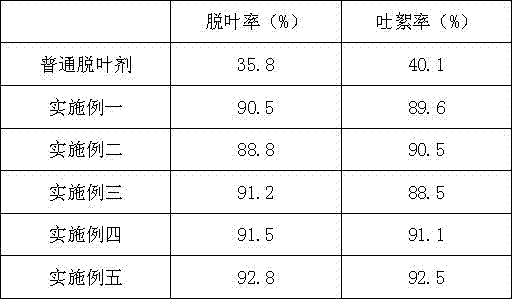Efficient cotton defoliating agent and synthesis method thereof
A defoliant and high-efficiency technology, applied in botany equipment and methods, biocides, animal repellents, etc., can solve problems such as environmental pollution, polluted soil, cotton killing, etc., and achieve improved defoliation rate and freezing point , The effect of simple production process
- Summary
- Abstract
- Description
- Claims
- Application Information
AI Technical Summary
Problems solved by technology
Method used
Image
Examples
Embodiment 1
[0015] The proportion of ingredients used is: 20 parts of ethephon, 10 parts of magnesium chlorate, 10 parts of thiadizuron, 12 parts of coronatine, 8 parts of polycondensed naphthalene sulfonate, 2 parts of carrageenan, and 10 parts of silky silicone additive parts, 15 parts of sodium lignosulfonate, 8 parts of hydroxyquinoline, 3 parts of ethylene glycol and 35 parts of deionized water.
[0016] The synthetic method of the present embodiment comprises the following steps:
[0017] A. Mix ethephon, magnesium chlorate, thiadizuron, coronatine, and polycondensed naphthalene sulfonate, add 1 / 2 deionized water, and perform mechanical stirring. The stirring speed is 1000 rpm, and the stirring time is 20 minutes. Obtain A mixture after standing;
[0018] B. Add carrageenan, silky silicone additives, sodium lignosulfonate, hydroxyquinoline, ethylene glycol and 1 / 2 deionized water to the mixture of A, add it to the reaction kettle after mixing, and heat the reaction kettle The temp...
Embodiment 2
[0021] The proportion of ingredients used is: 40 parts of ethephon, 20 parts of magnesium chlorate, 25 parts of thiadizuron, 22 parts of coronatine, 15 parts of polycondensed naphthalene sulfonate, 6 parts of carrageenan, and 20 parts of silky silicone additive parts, 20 parts of sodium lignosulfonate, 17 parts of hydroxyquinoline, 10 parts of ethylene glycol and 55 parts of deionized water.
[0022] The synthetic method of the present embodiment comprises the following steps:
[0023] A. Mix ethephon, magnesium chlorate, thiadizuron, coronatine, and polycondensed naphthalene sulfonate, add 1 / 2 deionized water, and perform mechanical stirring. The stirring speed is 1000 rpm, and the stirring time is 20 minutes. Obtain A mixture after standing;
[0024] B. Add carrageenan, silky silicone additives, sodium lignosulfonate, hydroxyquinoline, ethylene glycol and 1 / 2 deionized water to the mixture of A, add it to the reaction kettle after mixing, and heat the reaction kettle The t...
Embodiment 3
[0027] The proportion of ingredients used is: 25 parts of ethephon, 12 parts of magnesium chlorate, 13 parts of thiadizuron, 14 parts of coronatine, 9 parts of polycondensed naphthalene sulfonate, 3 parts of carrageenan, and 12 parts of silky silicone additive 16 parts of sodium lignosulfonate, 10 parts of hydroxyquinoline, 5 parts of ethylene glycol and 38 parts of deionized water.
[0028] The synthetic method of the present embodiment comprises the following steps:
[0029] A. Mix ethephon, magnesium chlorate, thiadizuron, coronatine, and polycondensed naphthalene sulfonate, add 1 / 2 deionized water, and perform mechanical stirring. The stirring speed is 1000 rpm, and the stirring time is 20 minutes. Obtain A mixture after standing;
[0030] B. Add carrageenan, silky silicone additives, sodium lignosulfonate, hydroxyquinoline, ethylene glycol and 1 / 2 deionized water to the mixture of A, add it to the reaction kettle after mixing, and heat the reaction kettle The temperatur...
PUM
 Login to View More
Login to View More Abstract
Description
Claims
Application Information
 Login to View More
Login to View More - R&D
- Intellectual Property
- Life Sciences
- Materials
- Tech Scout
- Unparalleled Data Quality
- Higher Quality Content
- 60% Fewer Hallucinations
Browse by: Latest US Patents, China's latest patents, Technical Efficacy Thesaurus, Application Domain, Technology Topic, Popular Technical Reports.
© 2025 PatSnap. All rights reserved.Legal|Privacy policy|Modern Slavery Act Transparency Statement|Sitemap|About US| Contact US: help@patsnap.com

